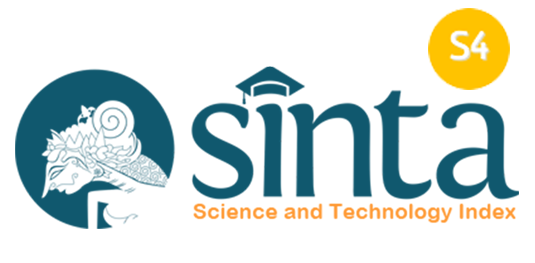The use of creative problem solving model to develop students’ adaptive reasoning ability: Inductive, deductive, and intuitive
Abstract
The use of creative problem solving model to develop adaptive reasoning ability: Inductive, deductive and intuitive
Keywords
Full Text:
PDFReferences
Ansari, B. I., & Sulastri, R. (2018). Validation of prototype instruments for implementing higher order thinking learning using the IMPROVE method. Journal of Physics: Conference Series, 1088(1), 012113.
Ansari, B. I., & Wahyu, N. (2017). Mathematics understanding and anxiety in collaborative teaching. Journal of Physics: Conference Series, 943(1), 012040.
Blakemore, S. J., & Frith, U. (2005). The learning brain: Lessons for education. Blackwell publishing.
Bransford, J., Donovan, S., & Council, N. R. (2005). How students learn: Science in the classroom. National Academies Press.
Brookhart, S. M. (2010). How to assess higher-order thinking skills in your classroom. ASCD.
Brophy, D. R. (1998). Understanding, measuring, and enhancing individual creative problem-solving efforts. Creativity Research Journal, 11(2), 123-150.
Chant, R. H., Moes, R., & Ross, M. (2009). Curriculum construction and teacher empowerment: Supporting invitational education with a creative problem solving model. Journal of Invitational Theory and Practice, 15, 55–67.
Conklin, W. (2011). Higher-order thinking skills to develop 21st century learners. Teacher Created Materials.
Creswell, J. W., & Creswell, J. D. (2017). Research design: Qualitative, quantitative, and mixed methods approaches. Sage Publications.
Dawkins, P. C., & Roh, K. H. (2016). Promoting metalinguistic and metamathematical reasoning in proof-oriented mathematics courses: A method and a framework. International Journal of Research in Undergraduate Mathematics Education, 2(2), 197–222.
Dumas, D., Schmidt, L. C., & Alexander, P. A. (2016). Predicting creative problem solving in engineering design. Thinking Skills and Creativity, 21, 50-66.
Fischbein, H. (1987). Intuition in science and mathematics: An educational approach (Vol. 5). Springer Science & Business Media.
Kemdikbud. (2013). Materi pelatihan guru implementasi Kurikulum 2013. Kementerian Pendidikan dan Kebudayaan.
Kilpatrick, J., Swafford, J., & Findell, B. (2001). Adding it up: Helping children learn mathematics. National Academy Press.
Korp, H., Sjöberg, L., & Thorsen, C. (2019). Individual development plans in the Swedish comprehensive school: Supporting high quality learning and equity, or rote learning and social reproduction?. Scandinavian Journal of Educational Research, 63(2), 229-244.
Kristanti, F., Ainy, C., Shoffa, S., Khabibah, S., & Amin, S. M. (2018). Developing creative-problem-solving-based student worksheets for transformation geometry course. International Journal on Teaching and Learning Mathematics, 1(1), 13–23. https://doi.org/10.18860/ijtlm.v1i1.5581
Lerís, D., Sein-Echaluce, M. L., Hernández, M., & Bueno, C. (2017). Validation of indicators for implementing an adaptive platform for MOOCs. Computers in Human Behavior, 72, 783–795.
Mitchell, W. E., & Kowalik, T. F. (1999). Creative problem solving. Retrieved on April, 4, 2004.
Mitchell, I. K., & Walinga, J. (2017). The creative imperative: The role of creativity, creative problem solving and insight as key drivers for sustainability. Journal of Cleaner Production, 140, 1872-1884.
Ostler, E. (2011). Teaching adaptive and strategic reasoning through formula derivation: Beyond formal semiotics. International Journal of Mathematics Science Education, 4(2), 16–26.
Pepkin, K. L. (2004). Creative problem solving in math. Retrieved from http://m2s-conf.uh.edu/honors/Programs-Minors/honors-and-the-schools/houston-teachers-institute/curriculum-units/pdfs/2000/articulating-the-creative-experience/pepkin-00-creativity.pdf
Rofiki, I., Nusantara, T., Subanji, S., & Chandra, T. D. (2017). Reflective plausible reasoning in solving inequality problem. IOSR Journal of Research & Method in Education (IOSRJRME), 7(1), 101–112. https://doi.org/10.9790/7388-070101101112
Treffinger, D. J., & Isaksen, S. G. (2005). Creative problem solving: The history, development, and implications for gifted education and talent development. Gifted Child Quarterly, 49(4), 342–353.
Wimer, J. W., Ridenour, C. S., Thomas, K., & Place, A. W. (2001). Higher order teacher questioning of boys and girls in elementary mathematics classrooms. The Journal of Educational Research, 95(2), 84-92.
Zohar, A. (2006). The nature and development of teachers' metastrategic knowledge in the context of teaching higher order thinking. The Journal of the Learning Sciences, 15(3), 331-377.
DOI: https://doi.org/10.18860/ijtlm.v3i1.9439
Refbacks
- There are currently no refbacks.
Copyright (c) 2020 International Journal on Teaching and Learning Mathematics

This work is licensed under a Creative Commons Attribution-NonCommercial-ShareAlike 4.0 International License.
Indexed by :
.png)
.jpg)
.png)

.jpg)


